This story was first published by the Philippine Center for Investigative Journalism
in collaboration with FYT Media
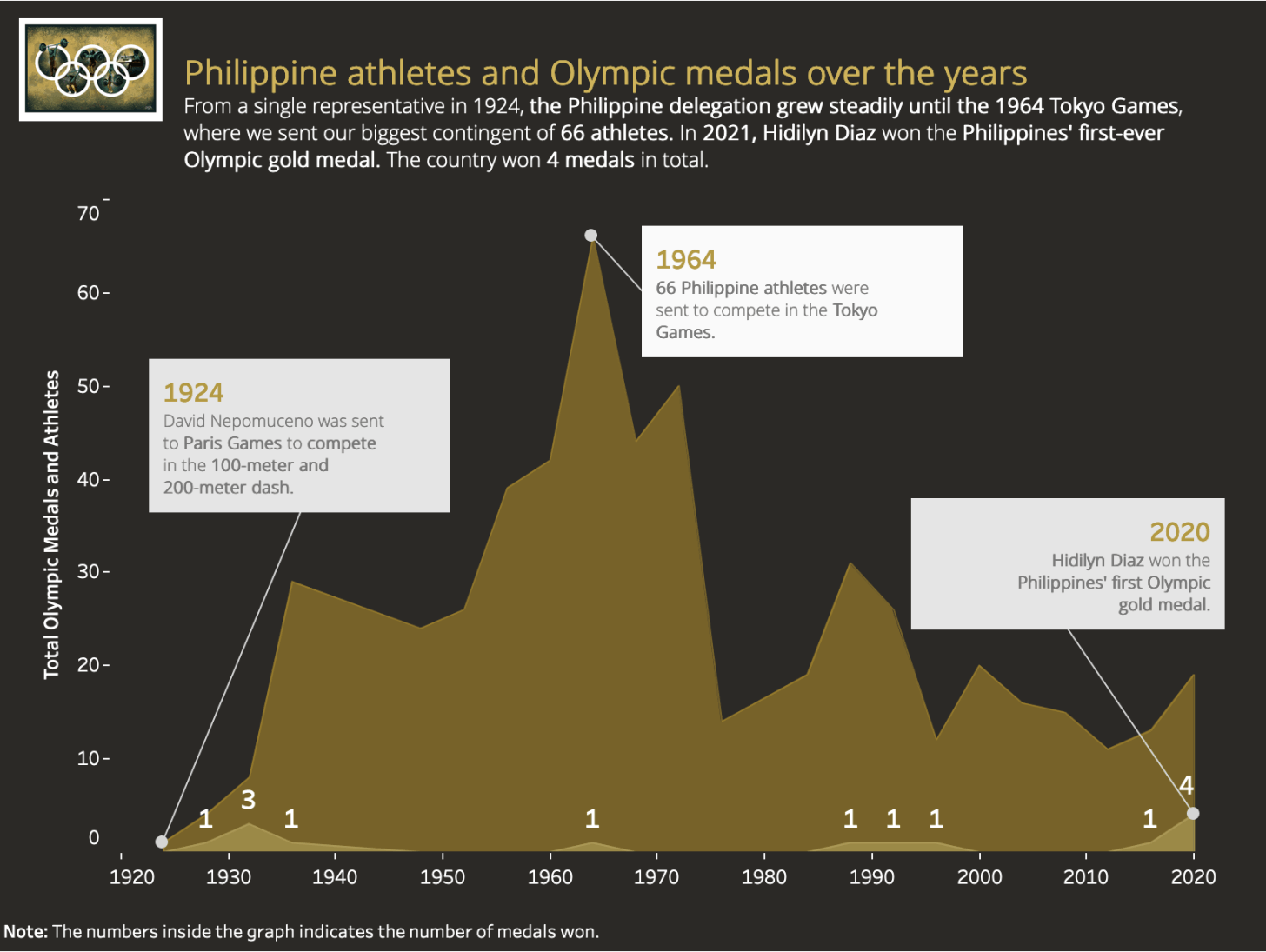
View this graphic in an interactive format: ANATOMY OF GOLD
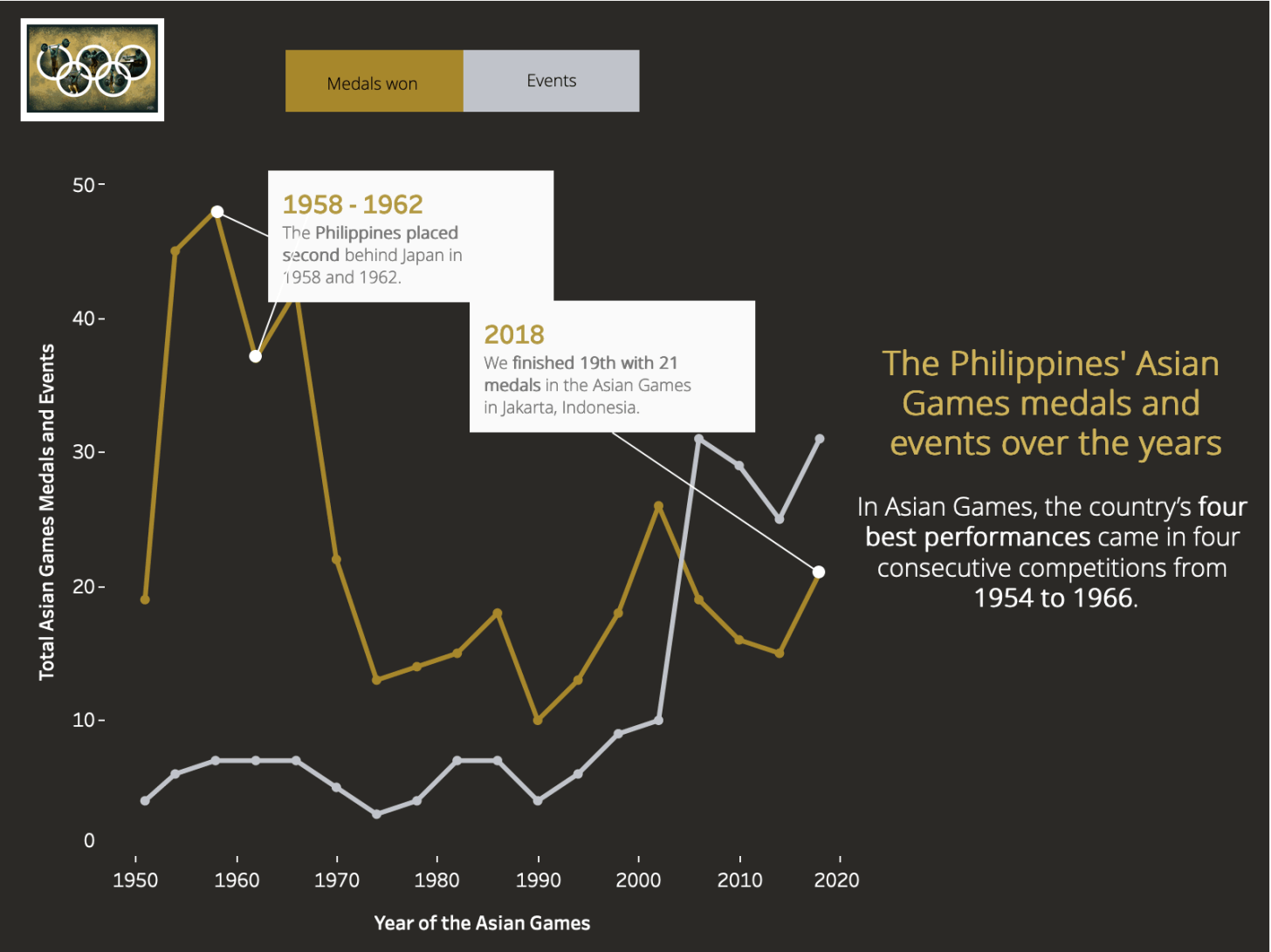
View this graphic in an interactive format: ANATOMY OF GOLD
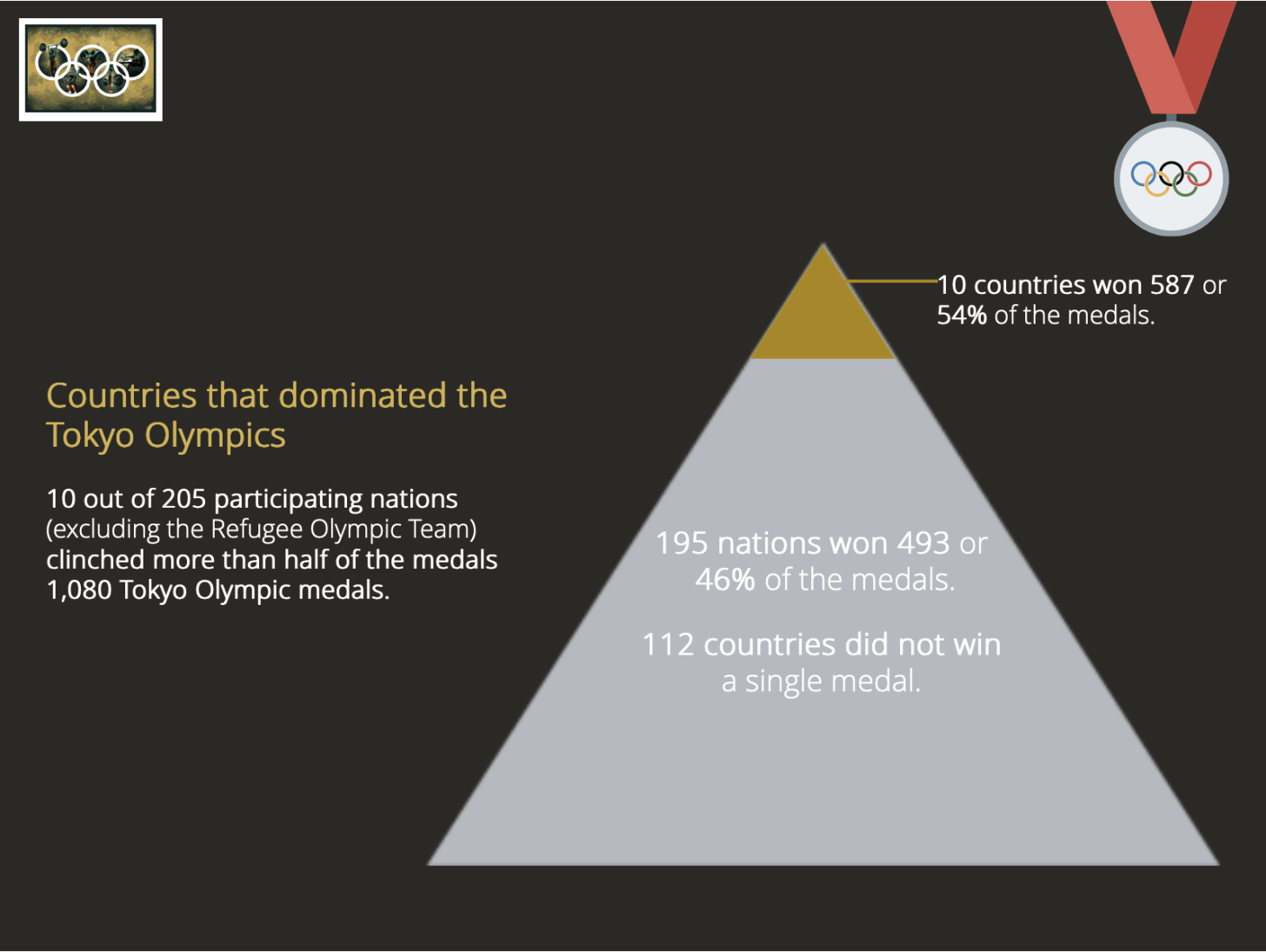
View this graphic in an interactive format: ANATOMY OF GOLD
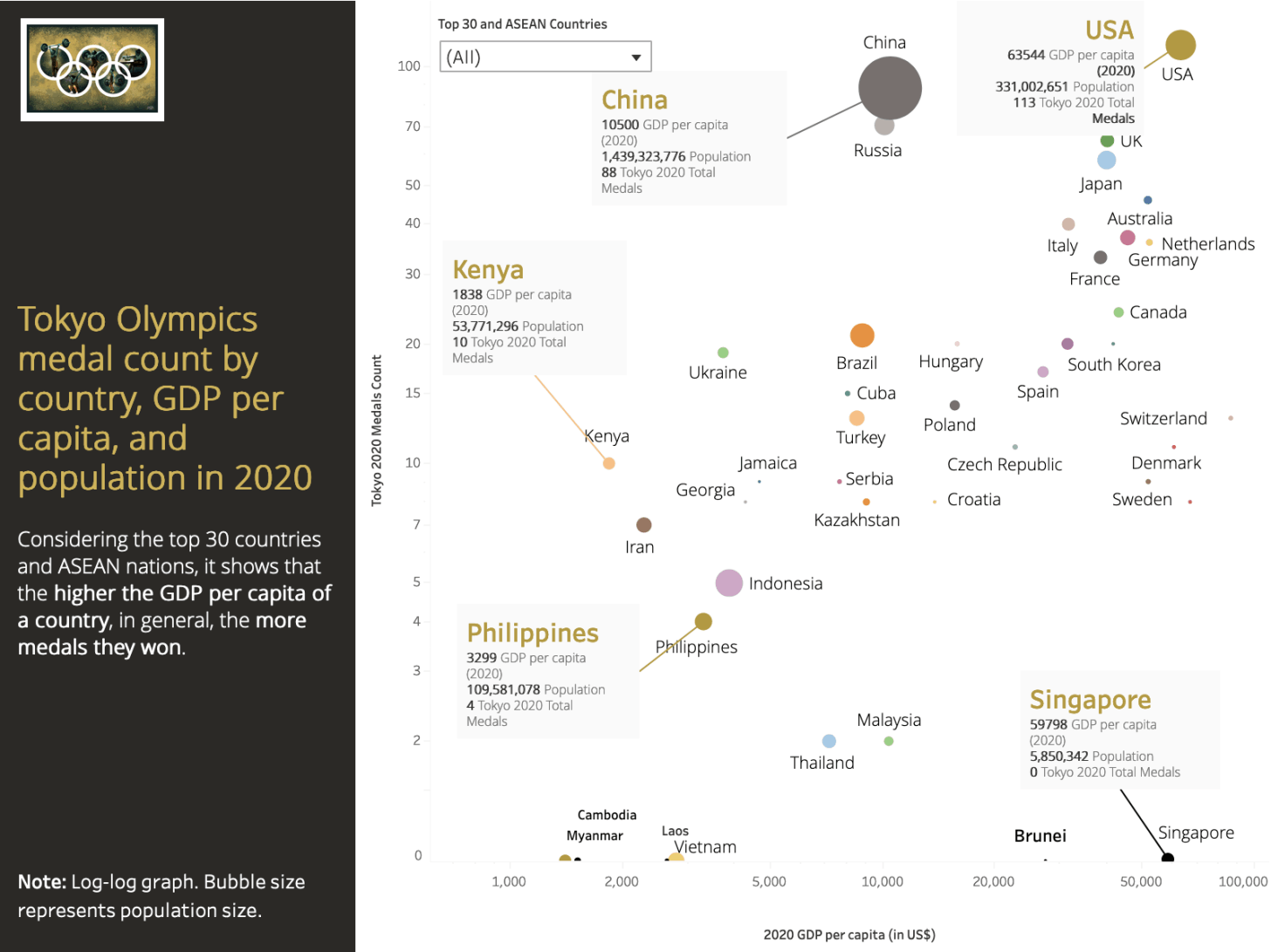
View this graphic in an interactive format: ANATOMY OF GOLD
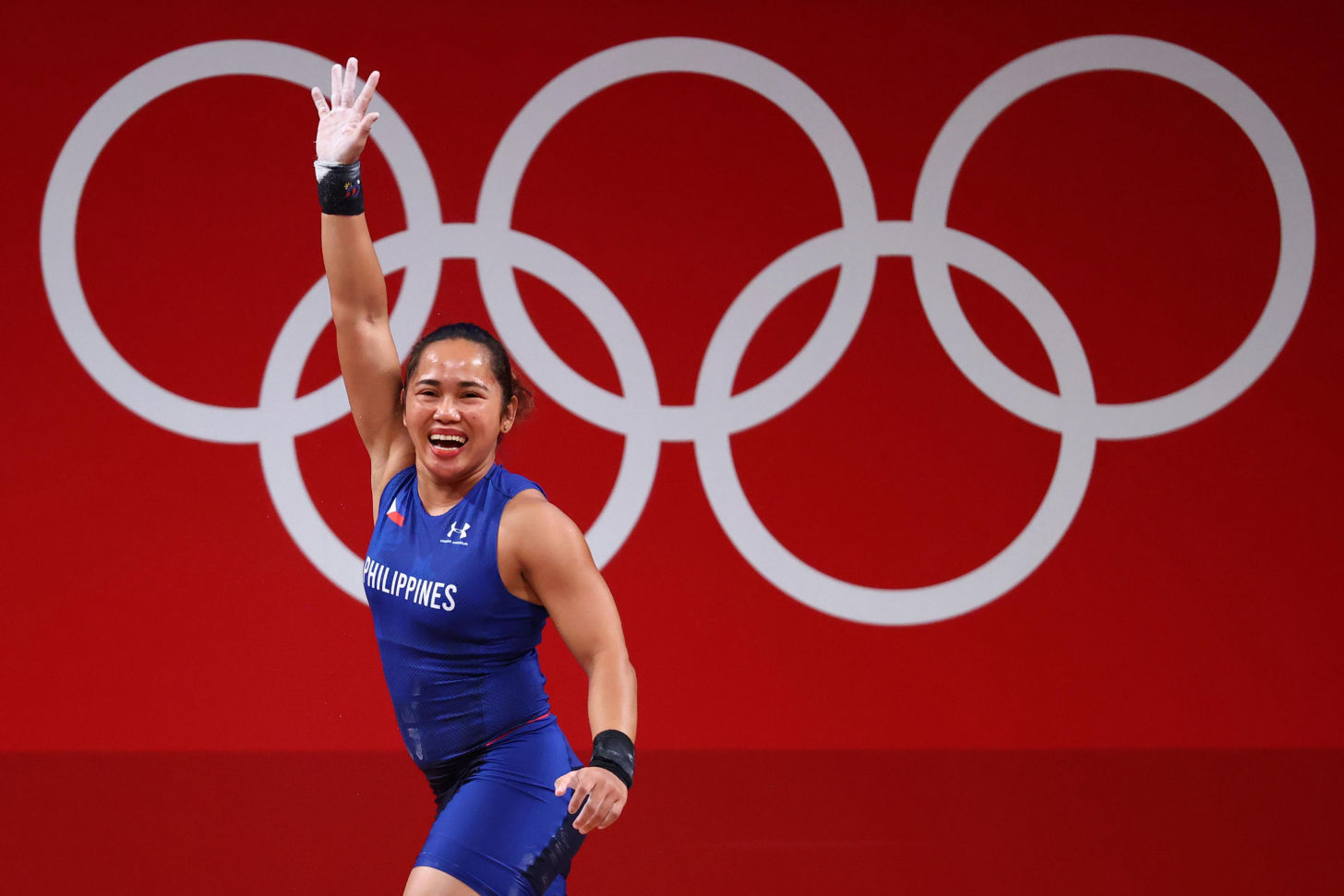
Hidilyn Diaz of the Philippines celebrates after a lift at the 2020 Tokyo Olympics. REUTERS/Edgard Garrido
“People said, ‘Don’t do that, that’s for men. Women should stay at home.’ They'll say you're an Amazon, a macho person. I got embarrassed. My mother told me no one would like me if I did weightlifting. So growing up as a girl I was insecure with my muscles.”
—
Hidilyn Diaz, Olympic Gold Medalist
“Our grassroots sports programs are very localized. They’re not coordinated at the national level, unlike in other countries. There are local leaders who say, ‘We’re a small municipality with very limited funding. Instead of spending on sports, we’d rather spend on agriculture and housing.’”
—
Anthony Divinagracia, sports journalist and political science lecturer
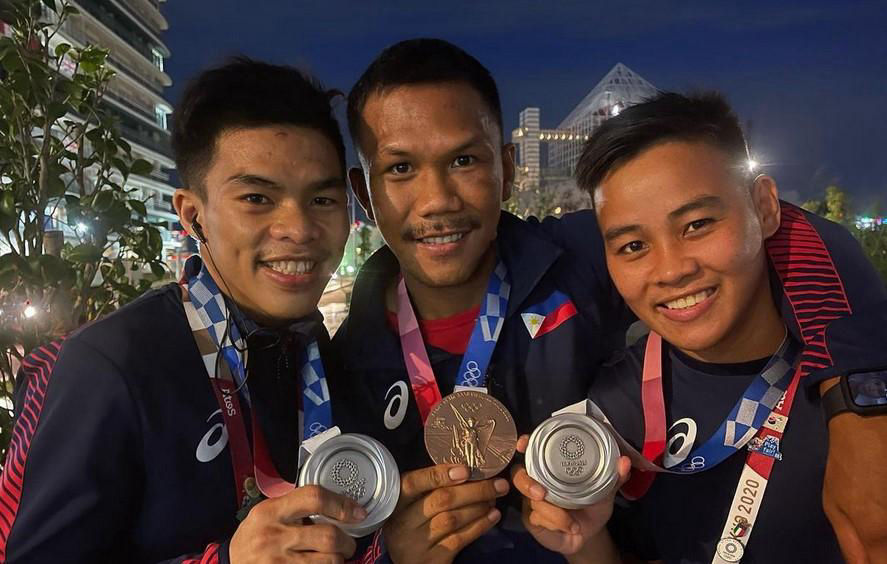
Filipino boxing medalists Carlo Paalam, Eumir Marcial, and Nesthy Petecio. Photo: Eumir Marcial/Instagram
"I really didn’t like boxing at first. I was forced to wear gloves and fight the kid. He beat me up, but his father saw that I was fearless and I had the potential. That’s how I started."
—
Carlo Paalam, Olympic silver medalist in boxing
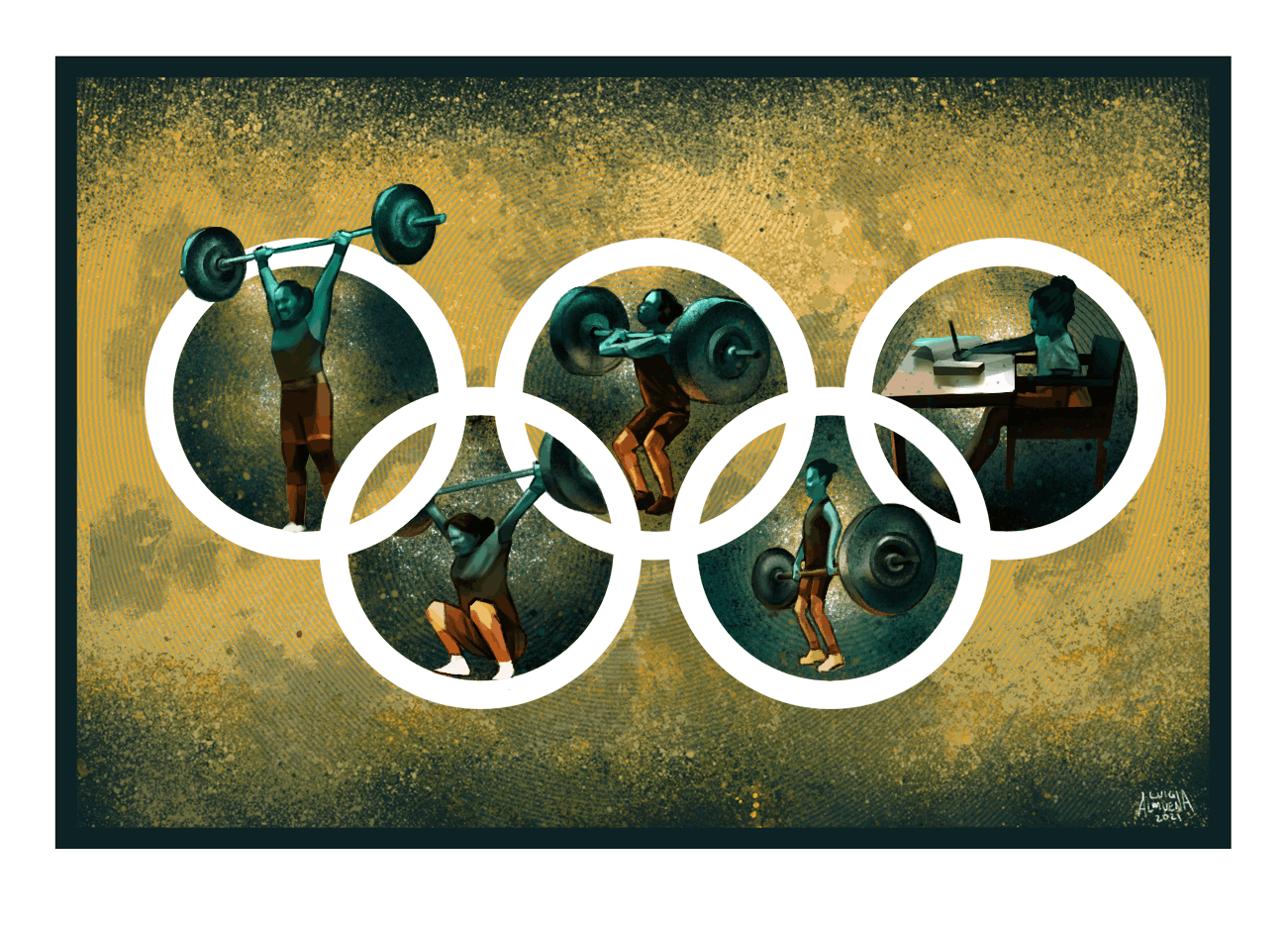
“I mean I love my coaches but, what they taught me, it’s not enough. If you really want to improve, you need to be exposed to world-class caliber [coaches] and world-class training.”
—
Gretchen Malalad, former national team karateka
Hidilyn had been to weightlifting powerhouse China twice even before her first Olympic Games. This was followed by even more training visits in subsequent years. To prepare for Tokyo 2020, our boxing team trained in Thailand under the watchful eye of an Australian coach. Pole vaulter EJ Obiena has been in Italy since 2014 with a Ukrainian mentor, while gymnast Carlos Yulo, who has a Japanese coach, has been based in Tokyo since 2016.
Malalad herself prepared in Italy for six months prior to the 2005 SEA Games under the mentorship of an Italian world karate champion. It was an invaluable experience.
“I mean I love my coaches but, what they taught me, it’s not enough. If you really want to improve, you need to be exposed to world-class caliber [coaches] and world-class training,” Malalad said.
It’s a privilege to be chosen for one of these trips, even for full-fledged members of the Philippine team. For starters, it’s costly. Malalad’s training overseas with three other national athletes was not paid for by the government but by a private sponsor, San Miguel Corp.
Even then, the money wasn’t enough. To stretch out their training as long as they could, the team stayed in a scrubby and dangerous neighborhood in Naples, one of the poorest cities in Europe, where rent was affordable. Their Italian coach helped them with their expenses, but Malalad and the others felt the need to look for jobs themselves.
“We were embarrassed. Our coach was already shouldering most of our training expenses, and we needed money to buy food and other essentials,” Malalad said.
The men tried working as dishwashers and cleaners at a restaurant, but had to quit when the heavy workload affected their training. Malalad picked up the slack. She took a job at a computer shop called Skynet that was frequented by African migrants and became a part-time tutor for migrant children.
“I remember, every Friday, I would get my pay and go to the grocery store to buy food for the team. I felt so happy. I was like a mom,” Malalad recounted.
The whole experience was grueling but worth it. Malalad won gold while the rest of the team also clinched medals in the 2005 SEA Games.
The advantage of international exposure can also be inferred from another quintessential feature of our elite sports representation: the Filipino diaspora. From basketball to football, athletics, swimming, and combat sports, we have been recruiting dual and naturalized citizens to the national teams for decades.
Filipinos have never been loath to welcome anyone under the flag, no matter how distant the connection and despite some criticism of the strategy. Five of our delegates to Tokyo 2020 were from this diaspora, and no less than two naturalized or dual-citizen Filipinos living abroad were part of each of our last four Olympic teams. This is worth noting for what it reveals: an edge for athletes trained or based overseas, where they have access to top coaches, the latest in sports science and innovation, and state-of-the-art facilities.
“There are those who say it is a band aid solution, and it’s not good because it displaces local athletes,” said political science professor Anthony Divinagracia. “But I don’t have a problem with it, because it raises the level of play. They have a different skill set because they are trained abroad. There’s a transfer of technology.”
In the Philippines, it’s difficult to even get a precise number of functioning sports facilities. We filed Freedom of Information (FOI) requests at the Philippine Sports Commission (PSC), but its response was limited. On the number of sports complexes in the country, the PSC identified a mere five, “to name a few.” These were the Rizal Memorial Sports Complex in Manila, the New Clark City Sports Hub, and one each in Bacolod, Davao, and Tagum City. This was clearly far from being a comprehensive list, as it did not even include the PhilSports Complex or Ultra in Pasig, where the PSC’s own office is located.
FOI requests on the number of regulation swimming pools, track ovals, and football pitches in the country got the same, narrow reply. A common sentiment in the sports community is that good training facilities in the country were lacking, and many of those that exist, particularly in the provinces, were in dire need of repair and maintenance.
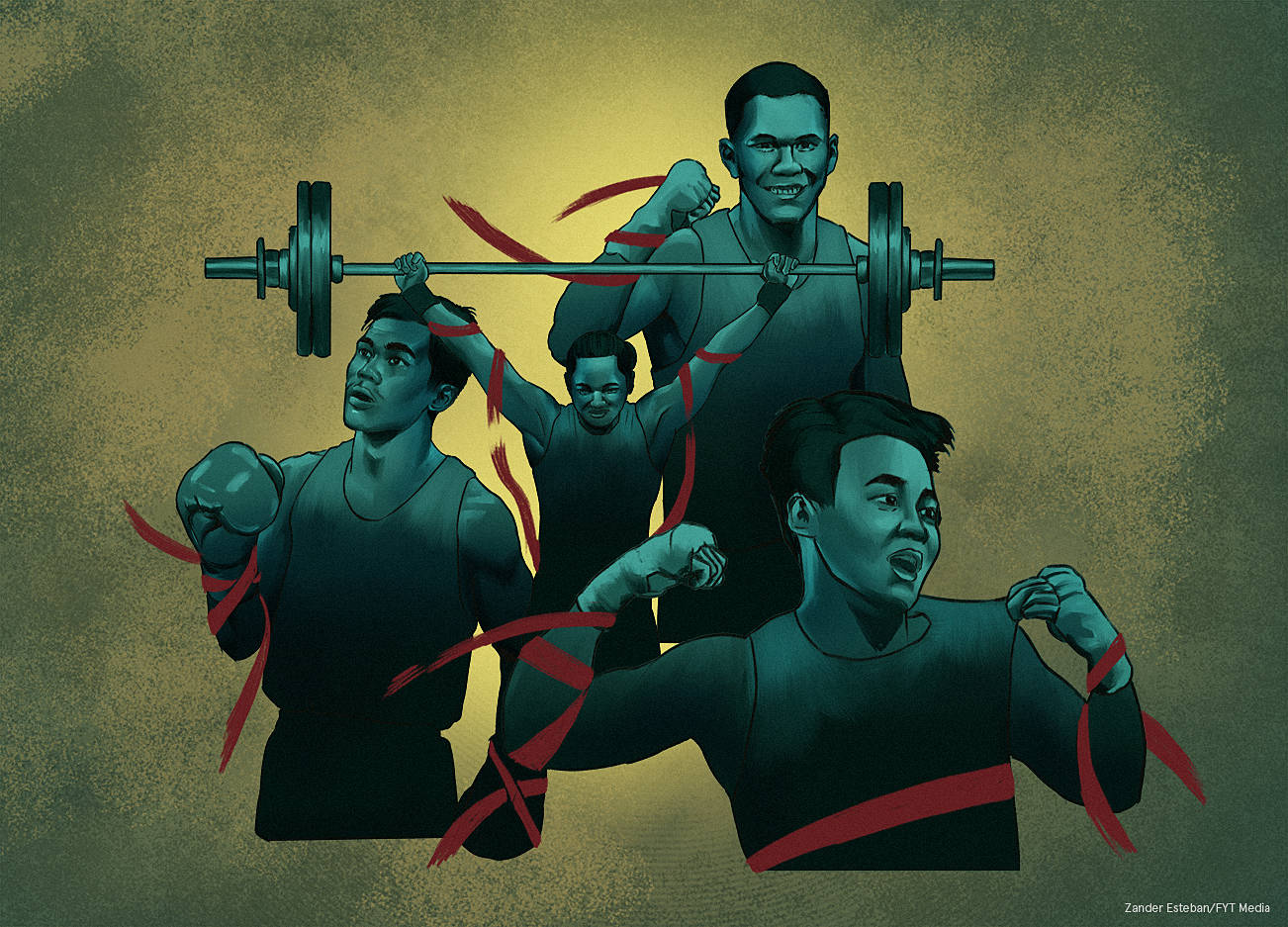
Hidilyn herself had to knuckle down in the decades-old weightlifting gym at Rizal Memorial after flaming out of the London Olympics. But further struggles came. In 2014, Hidilyn suffered a serious knee injury and failed to qualify for the Asian Games, putting her Olympic dreams in doubt. Critics began saying she was washed up. She sorted through the same emotions herself, spiraling into depression.
“I was physically, emotionally, mentally drained, and my performance was no good. I told myself I was a loser, a has-been,” Hidilyn recounted.
But in what has become a theme in her career, Hidilyn dug her way out of the quicksand. She decided to overhaul her conditioning program and dropped down to the 53 kg division. It proved to be a masterstroke. She started winning again. After a string of podium finishes in international competition, Hidilyn slowly rebuilt her confidence. In 2016, she was back at the Olympics.
In Rio de Janeiro, she finished strong. Hidilyn clinched silver, ending a 20-year medal drought for the Philippines. Back home, she became an overnight sensation.
“I was shocked when the airplane landed. Why were there so many people? They swarmed around me. We’re not used to that (as athletes), because we just train and compete,” she said. “ I realized that it was more than just a medal. There was a deeper meaning to it.”
Having proven herself on the world stage, Hidilyn immediately set her sights on Tokyo. But crossing the divide between gold and silver was not going to be easy. Hidilyn admitted she did not expect to place second in Rio, ready to settle for bronze instead. But the disastrous performance of a Chinese rival, who, like Hidilyn back in 2012, registered a DNF result, moved her up the ranking.
Hidilyn could not let her fate rest on the poor showing of opponents if she wanted to win gold. By 2020, she would be four years older and facing younger competition (it turned out to be five years older, since the Olympics got delayed by a year). Hidilyn looked at the odds and made a candid assessment: she was not going to win without making important changes. Pursuing those changes would be harder than she thought.
It boils down to money: how much or how little of it we allocate to sports. Countries that spend more on elite sports perform better on the world stage, research confirms. De Bosscher, Shibil, and Westerbeek (2015) found that 68% of a nation’s success at the Summer Olympics can be explained by absolute investment in elite sports. This is a substantial association for a single determinant. However, unlike macroeconomic figures like wealth and population, transnational comparisons of sports expenditure can be tricky. This is because spending definitions and delivery mechanisms vary considerably from nation to nation. In the study, significant methodological adjustments and fine-tuning were required to make meaningful comparisons between 15 sample countries.
In other words, there are many models for funding sports. For example, unlike other leading Olympic nations, the US does not have a government funded sports agency. National governing bodies get money from corporate sponsors and broadcast rights agreements — although some groups have been requesting for government help of late. On the other hand, rival China has adopted a state-driven strategy to international sporting competitions. This approach stands on firm financial backing. In 2016 for example, China’s General Administration of Sports (GASC) received $651million in government funding. This was 25 times the budget of the Philippines in 2021 (US and China were not part of the 2015 study).
In the Philippines, money for elite sports comes from a combination of government funds and corporate sponsorship. Here, there are encouraging developments. The budget of the PSC, the country’s sports agency, grew significantly in the last two years. Excluding 2019, an outlier because of the country’s hosting of the SEA Games, PSC budgets for 2020 and 2021 were each five to six times greater than where it was in 2018. In those two years, P750 million was allocated to preparation, training, and participation in the Olympic and Paralympic Games, roughly a third of the allotment.
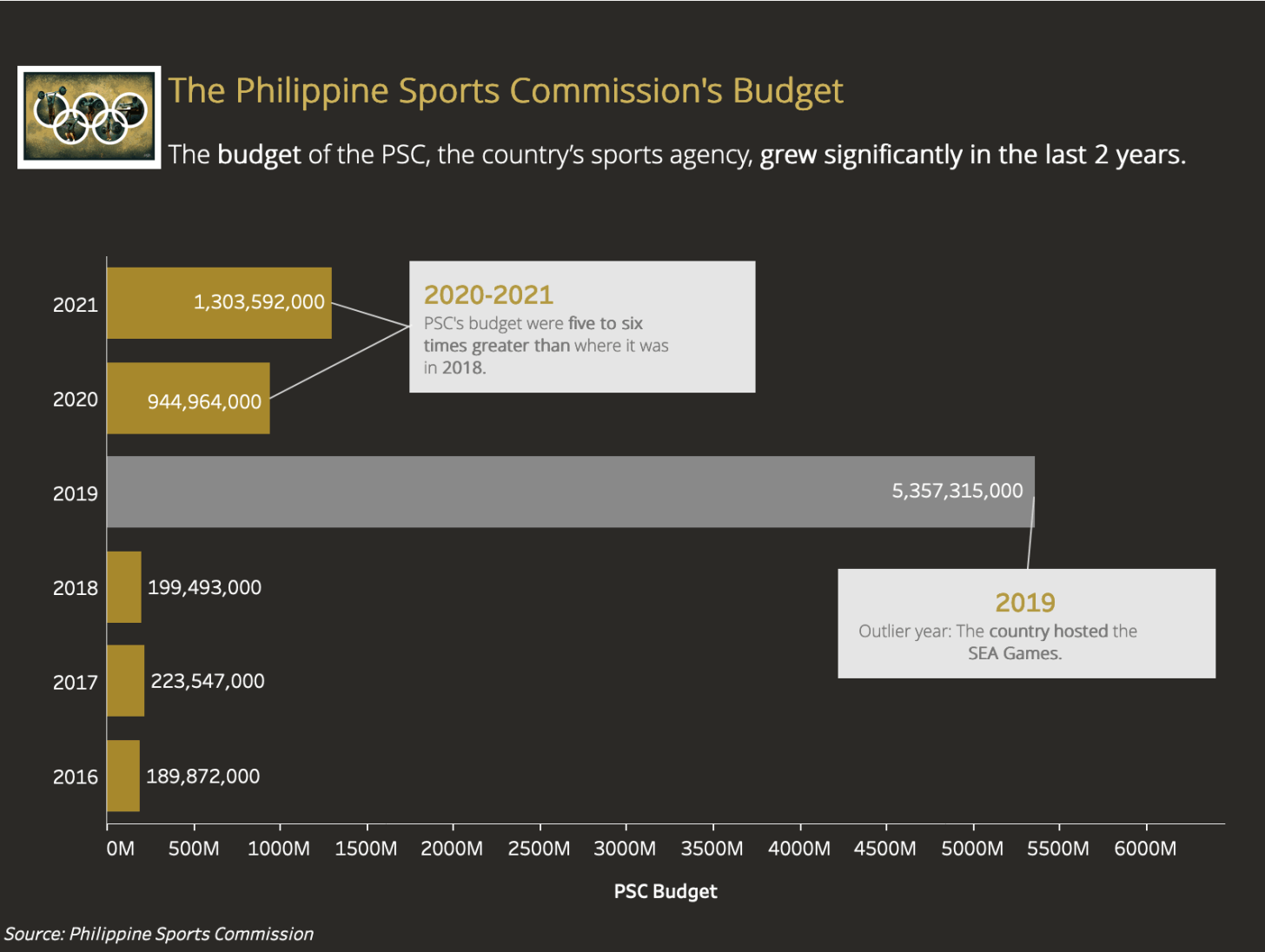
View this graphic in an interactive format: ANATOMY OF GOLD
PSC also receives remittances from the Philippine Amusement and Gaming Corp. (Pagcor) and the Philippine Charity Sweepstakes Office (PCSO). Under Republic Act 6847, the law that created the PSC, Pagcor is mandated to turn over 5% of its gross income to the government sports agency. Likewise, PCSO should remit 30% of the proceeds of six sweepstakes or lottery draws per annum. However, Pagcor has only been contributing 2.1%of its gross income since 1993 on the strength of a memorandum order from then President Fidel Ramos, supposedly to address the energy crisis at the time. The PCSO has also been accused of not remitting its full share since 2006.
Private funding is more difficult to track and quantify because of the scarcity of publicly available documents. Sponsors can go directly to an athlete, or more commonly, through the fund-raising efforts of national sports associations or NSAs: autonomous, nongovernment organizations that have control over the governance, promotion, and development of their sport.
One of the benchmarks of success of NSAs is how much corporate sponsorships they have raised. But they also receive varying subsidies from the government, ostensibly based on performance and need. In its approved outlay for 2021, the PSC had line-item budgets of P8.7 million for the Philippine Bowling Federation, P3 million for the Samahang Kickboxing ng Pilipinas, and P10 million each for the Philippine Football Federation and the Samahang Basketbolista ng Pilipinas.
The PSC is also responsible for giving a monthly allowance to national athletes and coaches. Athletes receive anything between P10,000 to P45,000 depending on their category, which is determined by their success in international competition. For national team members who train almost year round and have no other means of support, this is their lifeline. They rely on the allowance not just for training and living expenses, but in many cases, to support their families. When the allowance suddenly dries up, it can cause a major disruption.
“It’s hard to focus on preparations for the Olympics when you know your family in the province is starving. It hurts to think about it when you’re the only one they depend on.”
—
Irish Magno, Olympian
That was what happened earlier this year when the subsidy was delayed for two months. In March, elite boxer Irish Magno caused a stir when she revealed her desperate situation in a now-deleted Facebook post.
“It’s hard to focus on preparations for the Olympics when you know your family in the province is starving,” she wrote in Filipino. “It hurts to think about it when you’re the only one they depend on. There has been no allowance for two months. That’s the only thing we athletes have been relying on. I hope it’s released soon.”
Later, Marcial spoke out in support of his teammate, who apparently got in trouble for her disclosure. “When we speak out it comes across as bad. Irish Magno was asked to delete her post,” Marcial also wrote on Facebook. “It brings down morale because we’re doing everything we can to win the gold medal but we’re not getting enough support.”
When it was his turn to get piled on, Marcial did not shrink back. The middleweight boxer explained that even when it arrived on time, their full allowance as national team members was not enough, especially for the lofty goals expected of them.
“You think an allowance of P43,000 a month is enough to prepare for the Olympics? Do you think I can rely on that for plane tickets, accommodation, food, coaching staff, supplements, masseur, etc.? Everything I mentioned was provided by private sponsors and of course my own money,” he wrote in another post.
To augment their income, some athletes enlist with the Army, Navy, Air Force, or Coast Guard while training for the national team. There, they earn a salary based on rank. Five of our Tokyo 2020 delegates, including all four medalists, are members of the uniformed services, earning between P29,000 to P31,000 a month. Being enlisted also provides athletes the security of a job after they’ve retired from the national team, when their peak years are behind them.
All this raises an important point: it’s expensive to be an elite athlete. The odds are stacked against those from modest backgrounds who don’t have the resources or support system to fund their training. Using enlistment as a proxy for evaluating socioeconomic status, only 32% to 38% of the Philippine delegation belonged to the uniformed services in the past four editions of the Summer Games. They are usually clustered around boxing, weightlifting, and athletics. This confirms that more elite athletes come from middle- to upper-class backgrounds despite representing a narrow slice of the population.
The PSC released the allowance it owed athletes days after Magno’s protestations. Hurt feelings between Marcial and boxing officials soon simmered down. Although harmony was restored, the episode gave a rare glimpse into the frustrations felt by members of the national team. As Malalad intimated, athletes were often hesitant to speak up.
“Athletes usually don’t complain. They’re scared of being picked on. What if they are no longer given opportunities?” Malalad said.
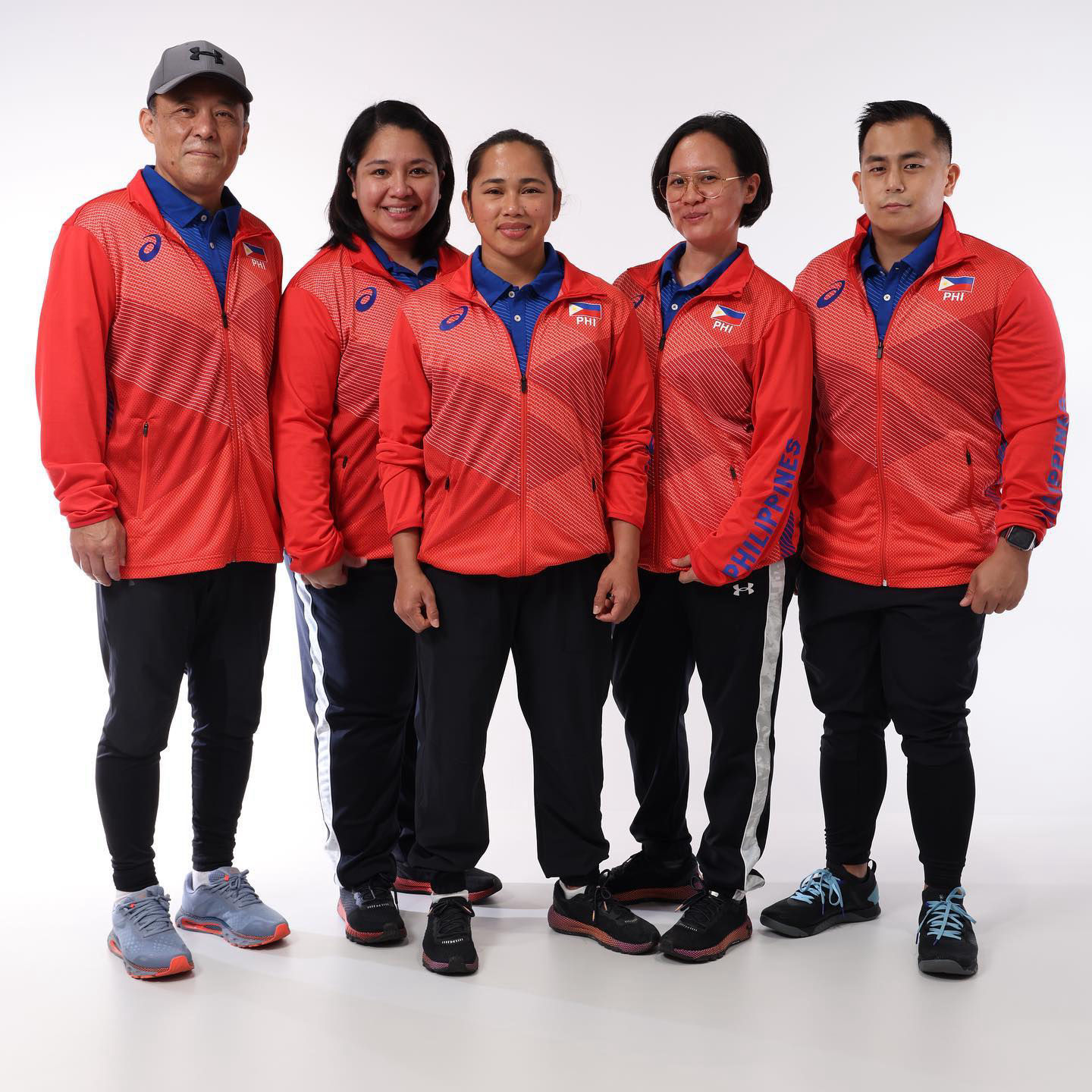
Team HD: Hidilyn Diaz (center) with Coach Kaiwen Gao, Dr. Karen Trinidad, Coach Jeaneth Aro, and Coach Julius Naranjo.
Photo: Hidilyn Diaz/Facebook
As she gained newfound influence following a podium finish in Tokyo, Hidilyn also found her voice. In mid-2018, she started assembling a team around her to focus on developing small details of her game. She was struggling against the law of diminishing returns; the smallest improvements required a lot more effort to achieve. But this is what elite sports are all about — an extra millimeter, one less millisecond, one more kilogram. “Team HD,” as it would later be called, started to take shape, composed of technical coach Gao Kaiwen from China, strength and conditioning coach Julius Naranjo from Guam (also Hidilyn’s partner), nutritionist Jeaneth Aro, and sports psychologist Karen Trinidad.
The Asian Games in Jakarta, a short two months away, would be the nascent team’s first test. Trailing Turkmenistan’s Kristina Shermetova by a kilogram after the snatch, Hidilyn took the lead with a 115 kg lift in the clean and jerk. Shermatova needed to lift 116 kg in her last attempt to edge Diaz out. She failed.
Hidilyn won. But behind the scenes, her nerves were showing. It was the same sport, but a different game.
“It was pressure for me for how many months,” Hidilyn was quoted after the competition. “At the Olympics no one expected me to win but at the Asian Games everyone expected me to win a medal, a gold medal. For months I couldn’t sleep, my training got ruined but with positive people surrounding me I got through it.”
A month later, back in the Philippines, Hidilyn tussled with Samahang Weightlifter ng Pilipinas (SWP) president and Bacolod Representative Monico Puentevella. In a scathing letter addressed to the PSC, Hidilyn vented her frustration over the state of weightlifting in the country. She accused Puentevella of not having a “strategic plan” and “long-term program” for athletes under their NSA. She challenged him to undergo an election process.
“I expected a lot of changes in weightlifting but sadly I saw some people who only use weightlifting for their own benefits and not for the benefits (sic) of our sports and athletes,” she wrote.
She wanted more support for her training and preparation. She fought to keep Gao, a proven high-caliber coach who Hidilyn believed could guide her all the way to gold. But the idea of a national athlete forming her own team seemed too cocky for the bureaucracy.
“(Sic) I had to endure several personal prejudice and criticisms from different sectors. I was immediately judged as ‘LumakiangUlo’ (swellheaded) and ‘mayabang’ (arrogant) just because I requested for additional support and stated what I really need in training,” her letter read.
Puentevella shot back, saying Hidilyn was being used by rivals who wanted to oust him from power. He also called Hidilyn ungrateful.
“Where did she start? Who brought her to the Olympics? I did, right?" he said.
In the end, Puentevella stayed on as president of SWP, while Hidilyn was able to keep Gao as her official coach. The two did not speak to each other for months, but their relationship gradually improved.
Unfortunately, Hidilyn’s burgeoning public profile also came with unexpected baggage. In early 2019, palace officials tagged her in a supposed plot to oust the president. The bizarre episode had Hidilyn fearing for her safety and that of her family back in Zamboanga. It also made her a target of attacks from the most hardcore supporters of the administration, who apparently believed the accusation without proof.
The incident only made it harder for Hidilyn to find support for her continuous training. For eight months, Naranjo, Hidilyn’s second coach, rendered his services for free. Every time she would request for a salary, she would get snide remarks from officials.
“Sports officials themselves bullied me, asking, ‘Where’s your sweetheart?’” She recounted. “Of course, I couldn’t foot the bill all the time. He helped a lot and that’s how he’s treated? The guy also has his needs.”
To pay for the services of Naranjo and her nutritionist, two core members of her team, Hidilyn made an appeal on social media. In an Instagram story, she wondered aloud if she could ask private companies to support her bid for gold. The president’s defenders, who were already suspicious of Hidilyn, saw it as another attempt to embarrass the government. The attacks intensified.
Training at Rizal Memorial at the height of the controversies, the champion weightlifter looked visibly troubled. “It’s hard to say publicly what we need. I’m already a silver medalist and I find it hard to speak out,” she said. “You can’t win in the Olympics just like that. I need to fight for other athletes. Because they’re afraid to speak up.”
But in the end, her gamble paid off. Hidilyn clinched substantial funding from organizations like the Udenna Group of businessman Dennis Uy and the MVP Sports Foundation of PLDT Chairman Manny Pangilinan. It was a huge boost for Team HD. Later, Gao would persuade Diaz to train overseas, away from the stress and distractions of Metro Manila.
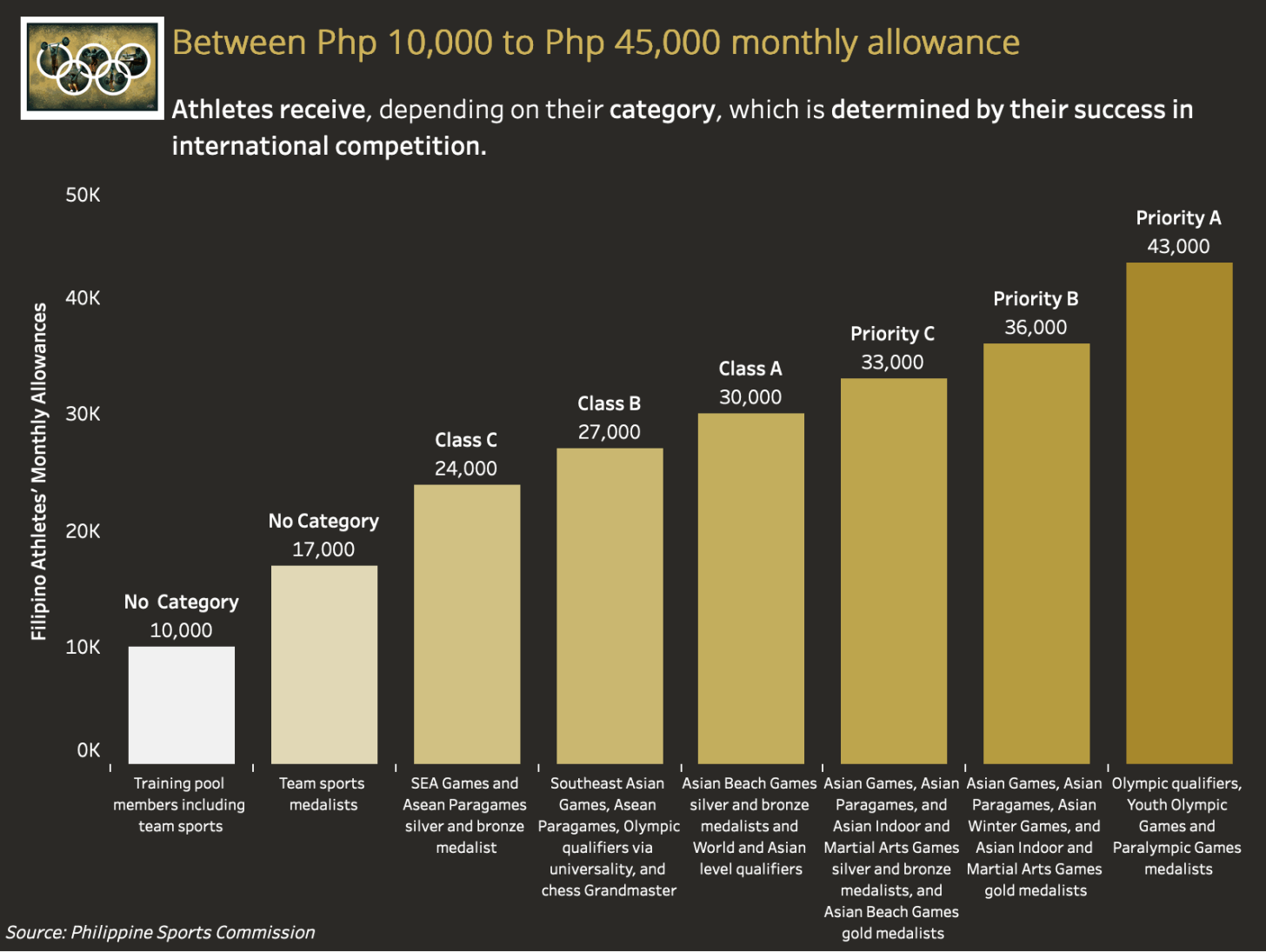
View this graphic in an interactive format: ANATOMY OF GOLD
There is no prescription for how much money countries should spend on their elite sports programs or individual athletes. Hidilyn estimates the cost of her preparation from 2019 to 2021 at P15 million, putting the price of her gold medal at about P5 million per year.
According to Hidilyn, about 60% of that was shouldered by the government while 40% came from the private sector.
It’s not just the deep pockets of corporate sponsors that make them attractive partners, but their expediency as well. Once they take you under their wing, there is less red tape to deal with, unlike government checks that can take a long time to get signed and released. Without sponsors, Hidilyn said she typically spent her own money for things like hotel bookings and plane tickets and hoped it would get reimbursed later.
Needless to say, there is also a downside to relying on private money. For one, corporate sponsors are under no obligation to fund any athlete, and may pick and choose whom to support and when.
“Private sponsors stepped up in the last Olympics. Funding and support became more consistent,” Divinagracia acknowledged. “But some private sponsors are too business-minded. They would say ‘no result, no trophy, sorry we will just cut the sponsorship.’”
Veteran sports broadcaster and academic Sev Sarmenta agreed that private money is fickle. But he also believed that the big funders would stick around for now.
“Until we can come up with a better way of financing our athletes we will have to turn to private sector support,” he said. “I have faith in them. I think it’s good public relations, it’s good community relations for them to stay in sports. I think most of them are interested in Filipinos winning in the Olympics and other events as well.”
Unfortunately, whether it’s in the form of government subsidy or corporate sponsorship, sports financing often has less to do with the athletes, and more on the dynamics of power in the sporting establishment. To understand why, we need to have a basic grasp of the local sports system.
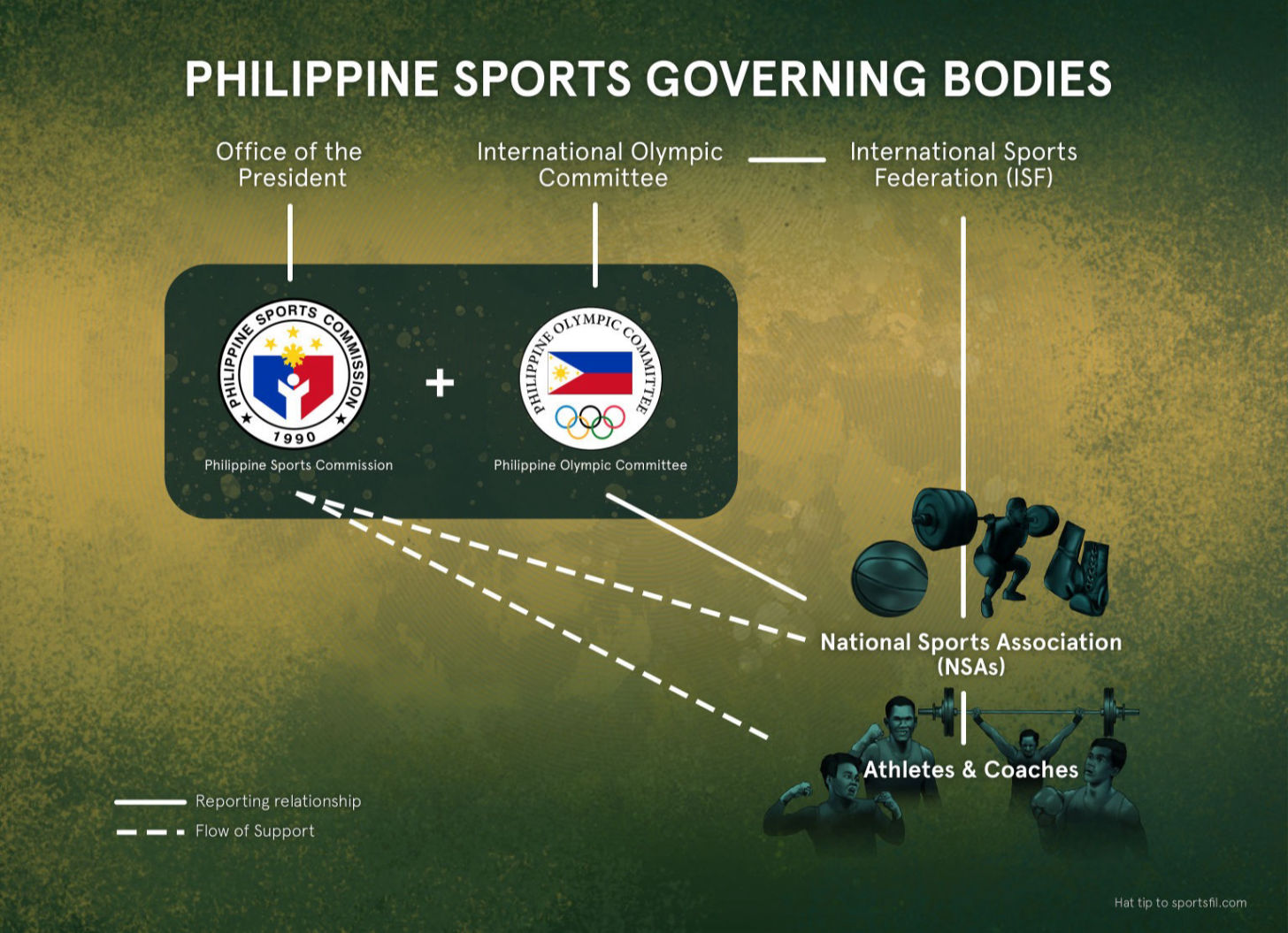
View this graphic in an interactive format: ANATOMY OF GOLD
We’re already familiar with the PSC, created in 1990 as the exclusive policy-making and coordinating body for all amateur sports development programs and institutions in the Philippines. Standing shoulder to shoulder is the Philippine Olympic Committee (POC), a private, nongovernment organization recognized by the International Olympic Committee (IOC) as having the sole authority to represent Philippine athletes in the Olympic Games, the Asian Games, the SEA Games and other multi-event competitions.
The POC serves as the umbrella organization of all NSAs locally. All NSAs must also be affiliated with International Sports Federations (IFs) that govern their sport at the global level. These IFs are also recognized by the IOC.
Most countries that participate in established international sporting events operate under a similar public-private setup. National Olympic Committees (NOC) are designed to be autonomous to “resist all pressures of any kind, including but not limited to political, legal, religious or economic pressures,” according to the Olympic Charter. That is, at least in theory.
Although the POC is financially independent, member NSAs are not. Most NSAs remain totally reliant on, and therefore constrained by, the amount of subsidy they receive from the PSC. The POC already has 42 regular NSA members and 13 associate members representing a myriad of sports, and that list continues to grow. Without a proportional increase in the budget, funding becomes more and more competitive. This is where things can get tricky.
“Politics comes into play because there’s spending involved,” Sarmenta said.
An examination of the leadership of the different NSAs and the POC reveals that many of them are either incumbent politicians or belong to prominent political families. This wearing of multiple hats has become inevitable under a system where different sporting groups vie for funding and influence.
“In my view, there should be no politicians there,” Divinagracia said. “But in several instances, these politicians have proved that their influence helped secure government funds and support. Because they’re in power and have money, they can chip in from their own pockets, right?”
But in other cases, politics gets in the way of what’s best for the sport. Divinagracia recalled an incident when a newly elected NSA president terminated all sponsorship deals arranged during the term of a bitter rival. No explanation was given. A new sponsor who offered to support the NSA was also rejected.
“The new president said, ‘Who’s that?’ ‘This businessman.’ ‘I don’t like him.’ ‘Why?’ ‘Because he’s our political nemesis, so it’s a no-go.’” Divinagracia said.
The same power play occurred when soliciting government funds.
“If you’re an NSA, you can ask for money from the Philippine Sports Commission. But you need to be endorsed by the POC. What if the POC does not want to endorse you because you have issues with them? You won’t get anything,” Divinagracia said.
Worst of all, athletes become collateral damage in the constant struggle between warring factions within the sporting establishment.
“That does not mean I don’t love the Philippines. I have good memories from there. But I did not have the connections needed to succeed in that culture.”
—
Wesley So, Filipino chess prodigy and US citizen
When chess prodigy Wesley So officially became a US citizen in February, extinguishing any hope that he could be persuaded to come back to the Philippines, the pervasive system of patronage was a particular reason he cited for leaving. Filipinos heaved a sigh of regret as the US Chess Federation published a photo of the Cavite native — a small American flag on his right hand and his citizenship papers on his left, unmistakable marks of his new allegiance.
In an interview with US Citizenship and Immigration Services, So, one of the best chess masters in the world and arguably the best Filipino player ever, said he just couldn’t make it in the local sports system.
“That does not mean I don’t love the Philippines. I have good memories from there. But I did not have the connections needed to succeed in that culture,” he said.
While So has not shared the specifics of his conflict with Philippine sports officials, he had previously expressed disappointment over being denied a P1-million incentive from the PSC and the POC after winning at the World Universiade Games in 2013.
In an email interview with Spin.ph arranged by his adoptive mother Lotis Key back when he was still a Filipino citizen, So’s criticism was blistering.
“To be poor and unconnected in the Philippines is to be trash for rich people to step on,” So said. “I am a true Filipino who cares about the future of Filipino children growing up in an endless cycle of corruption and zero opportunity. My heart aches for talented people there who because of poverty haven’t any hope for their futures.”
POC President Bambol Tolentino, who was elected to the position in 2019, readily admitted that local sports is mired in politics. He insisted however that reforms were being made.
“The old boys’ club was there when I came. There’s politics, and it’s dirty,” he said. “But we went past that, with the other groups that believe in good governance and transparency.”
Tolentino, a deputy speaker of the House of Representatives, has been a congressman since 2013. Prior to Congress, he was mayor of Tagaytay for nine years. As a firmly established politician, Tolentino was candid about the advantages his position and connections brought to the POC.
“All our requests were granted [by the national government]. Well maybe, because I’m in Congress, so I know the ins and outs of their budget,” he said.
“Like those pledges [from companies], I personally talk with them. [We get] a big appropriation with just a text message, a phone call.”
We tried to interview the leadership of the PSC for this story but they did not respond to our requests.
Sarmenta observed that there seemed to be a good engagement between the POC and PSC at the moment, something that shouldn’t be taken for granted. Ramirez and Tolentino are known allies of the Duterte administration.
“It’s personality-based. There were years when the PSC and the Philippine Olympic Committee did not see eye to eye. Because PSC has the money bags, they took care of funding. When they were at odds with the POC president and the different NSAs, the funding would stop,” Sarmenta explained.
Doubtless, a historic Olympic performance helps smoothen the relationship.
“When we start winning, there’s no acrimony, right? But there were so many years when we had no medals to take home. When we lose, there’s a lot of blame to go around,” Sarmenta said.
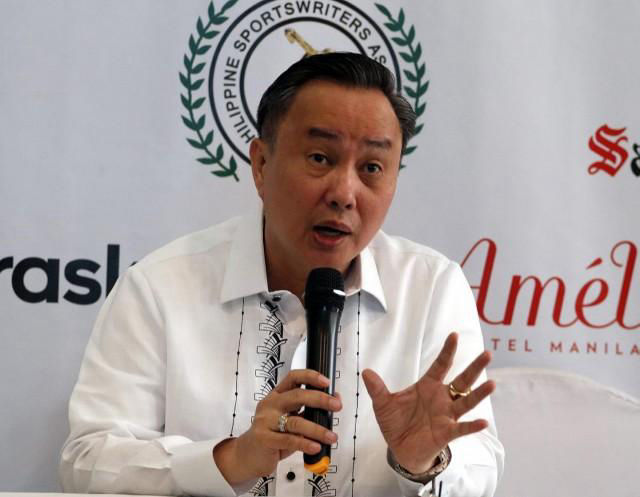
Cavite Rep. Abraham Tolentino is the president of the Philippine Olympic Committee. Photo: Philippine Sportswriters Association
Despite the weaknesses in the local sports system, Sarmenta believes the present model will have to work for now. A particular development he looked forward to is the newly established National Academy of Sports or NAS, a government-run public high school with a curriculum focused on sports. NAS was established on June 9, 2020, and is an attached institution of the Department of Education. Its main campus is in the New Clark City Sports Complex in Capas, Tarlac. NAS has launched a nationwide search for scholars for its inaugural school year.
“The concept is to have athletes go to school and study while being trained. They are the ones who have been selected from the grassroots program.” Sarmenta said. “If the seeds are planted correctly, we can make harvests quite well into the future.”
The idea is not new and has been used in other countries to great effect, the La Finca boxing academy in Cuba being a prime example. But the NAS also harks back to the Gintong Alay program of the 1980s under the administration of former dictator Ferdinand Marcos. Back then, talented student-athletes were housed in a training facility in Baguio where they also attended school. While Gintong Alay eventually expanded to include multiple sports, the program initially focused on track and field, a medal-rich sport with several disciplines.
One of the famous alumni of the program is Elma Muros-Posadas, also known as the “Long Jump Queen,” and winner of an impressive 15 SEA Games gold medals. She’s now a coach and grassroots coordinator for the PSC.
Elma recalled her days of training in the summer capital of the Philippines, surrounded by a battery of coaches and specialists, both local and foreign. The program was run by Michael Keon, a nephew of Marcos who also served an overlapping tenure as president of the POC. Keon is now mayor of Laoag, Ilocos Norte.
“We were really focused on competing, training, sleeping, studying, performance, that’s it. Sir Mike told us not to think of anything else,” Elma recounted. “He even took care of our family. He said, ‘I will even help your family with their medical treatments. So even when they got sick, we couldn’t go home to the province.”
For Elma, who hails from the small town of Magdiwang, Romblon and was only a teenager at the time, the comprehensive support from Gintong Alay allowed her to focus on training with minimal distractions. On one occasion, Elma’s parents were brought to Baguio for a week so they could visit their daughter during a rough patch. The program paid for everything.
“We were happy because our parents didn’t have to pay for lodging and meals. We didn’t care about money, as long as we were provided for and we didn’t have to think about anything else except for studying, training and competing.”
Gintong Alay found noteworthy success, at least in regional competitions like the SEA Games. The country finished second overall in 1983, and third in 1985 and 1987. We also brought home several gold medals from the Asiad and Asian Athletics Championships, six of them courtesy of Lydia de Vega, another Gintong Alay alumnus who was considered Asia’s fastest woman in the 1980s.
Despite its achievements, Gintong Alay may be considered the ultimate expression of patronage politics in local sports. It was the program of a regime that exerted total control over the nation and carefully managed its image overseas. Notwithstanding rumored internal struggles, Keon, the dictator’s nephew, had easy access to funding and support for the program, and was presumably empowered to direct all of its affairs. It would be imprudent to evaluate Gintong Alay outside of the events and political climate at the time. The program ended in February 1986 following the ouster of President Marcos from power.
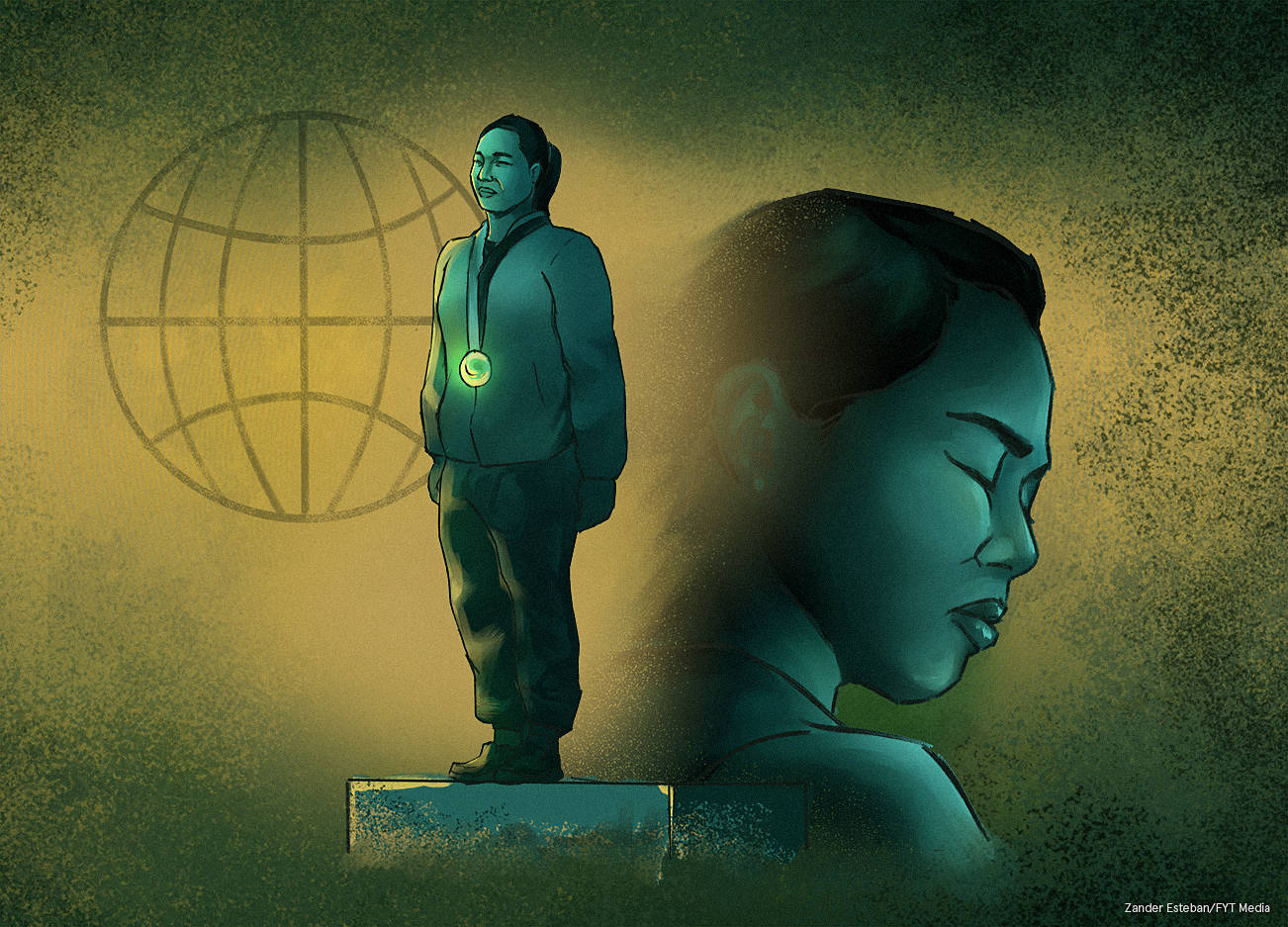
A few months away from the Olympics, and with a pandemic rampaging around the world, sports fans would see vignettes of Hidilyn’s non-stop training through her Instagram and YouTube channel, which she updated regularly. She had been stuck in Malaysia for months because of movement restrictions, and had to get creative with her workouts. In one video, she was sprinting up a parking ramp. In another, she was doing overhead squats using a bamboo pole and two large water containers as weights. It was a familiar scene. Twenty years since she started lifting, Hidilyn was back to improvising.
Hidilyn and her two coaches eventually found a home with a local weightlifting official, who graciously renovated the garage of his mother-in-law’s house in Melaka to turn it into a makeshift gym. The small space was all Hidilyn needed. She got down to work, her daily workouts punctuated by clucking hens and the intermittent putter of passing motorcycles.
She would complete the rest of her training in this rural village, far from home, before flying to Tokyo for the Olympics. Her coaches said Hidilyn was in the best shape of her career. The friendship of our Southeast Asian neighbors and her never-give-up attitude had saved the day. After she left, a tarpaulin emblazoned with Hidilyn’s photo and the words “GOOD LUCK” still hung on one side of the garage.
In the world of sports where success is determined in unambiguous terms, it is still the intangibles that capture our imagination. Courage, grit, determination, puso (heart). These become powerful weapons in the hands of Filipino athletes who are forged in the fires of adversity, in a nation where sports is still a matter of survival for many.
But Hidilyn refused to romanticize her journey and chose to put things into perspective. “Having heart is not enough. Support is needed, preparation is needed for greatness to come out.”
During difficult times, and those times are frequent, it’s understandable for sports to take a back seat. We need to eat, stay safe, and keep a roof over our heads. But who would say sports, when done right, is not a worthy investment? Seldom can something have the power to raise an entire nation’s esteem, eclipse a hundred years of failure, and reduce a plague into a footnote.
As Hidilyn stepped into position for her winning lift, we didn’t know that feeling yet. But an immortal moment was within reach. She was about to seize it.
In-depth special reports and features showcasing the best multimedia storytelling from GMA Integrated News.